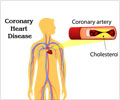Nearly one in five patients experiences chest pain one year after having a heart attack.
Nearly one in five patients experiences chest pain one year after having a heart attack, according to a report in the June 23 issue of Archives of Internal Medicine, one of the JAMA/Archives journals.
One of the main goals of in-hospital treatment and outpatient care after heart attack is to relieve angina (or episodic chest pain), according to background information in the article. The prevalence and treatment of chest pain one year after heart attack are largely unknown. “By identifying these factors, a more complete understanding of those patients who are at the greatest risk for angina [chest pain] after myocardial infarction [heart attack] can occur,” the authors write. Identifying this population is important for treating remaining chest pain and improving patient outcomes, including ability to exercise and health-related quality of life.Thomas M. Maddox, M.D., S.M., of Denver Veterans Affairs Medical Center and University of Colorado Denver, and colleagues studied the occurrence of angina in 1,957 patients recruited from January 2003 to June 2004. Patients filled out questionnaires assessing their chest pain one year after hospitalization for heart attack. Sociodemographic, clinical and other lifestyle factors were also reported.
Of all patients, 389 (19.9 percent) reported angina one year after hospitalization for heart attack. Twenty-four patients (1.2 percent) reported having daily chest pain, 59 (3 percent) reported weekly chest pain and 306 (15.6 percent) reported having chest pain less than once a week.
Patients experiencing chest pain one year after heart attack were more likely to be younger, non-white males with prior chest pain who have undergone prior coronary artery bypass graft surgery and have experienced recurring rest chest pain while hospitalized for heart attack. Patients with one-year chest pain were also more likely to continue smoking, to undergo revascularization (surgery to reestablish blood flow to the heart) after hospitalization and to have significant new, persistent or fleeting depressive symptoms.
“Multiple factors were associated with one-year angina, including demographic, clinical, inpatient and outpatient characteristics. Recognition of these relationships will be important in monitoring at-risk patients after acute myocardial infarction,” the authors conclude. “In addition, future investigation into modifiable factors, such as depression and smoking cessation, will be important in the quest to alleviate angina and improve subsequent cardiac outcomes among patients after myocardial infarction.”
Source-Newswise
SRM











